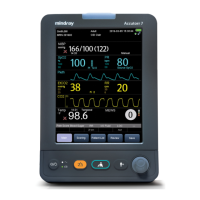4-2
4.2.2 Visual Inspection
Perform an overall inspection on the appearance of the equipment. The test is passed if the
equipment has no obvious signs of damage. Follow these guidelines when inspecting the
equipment:
Carefully inspect the case, display screen, buttons, and knob for obvious signs of
damage.
Inspect all external connections for loose connectors, bent pins or frayed cables.
Inspect all connectors on the equipment for loose connectors or bent pins.
Make sure that safety labels and data plates on the equipment are clearly legible.
4.2.3 SpO
2
test
Test Method 1
Tool required:
None
Test procedure:
1. Connect SpO
2
sensor for adult to the SpO
2
connector of the monitor. Set [Patient
Category
] to [Adult].
2. Place the SpO
2
sensor on your finger.
3. Verify the Pleth Wave and Pulse Rate are displayed on the screen.
4. Remove the SpO
2
sensor from your finger and make sure that the SpO
2
Sensor Off
alarm is triggered.
Measurement validation
The SpO
2
accuracy has been validated in human studies against arterial blood sample
reference measured with a CO-oximeter. Pulse oximeter measurements are statistically
distributed, and only about two-thirds of the measurements can be expected to fall within
the specified accuracy compared to CO-oximeter measurements.
NOTE
The SpO2 simulator can only be used to verify that the pulse oximeter
operates properly. It cannot be used to verify the accuracy of the pulse
oximeter or the SpO2 sensor. To verify the accuracy, clinical tests are
required.
Test Method 2
Tool required:
SpO
2
simulator, Index-2 recommended
Test procedure:
1. Connect the SpO
2
sensor to the SpO
2
simulator.
2. Selected the model and manufacturer of the SpO
2
module to be tested on the
simulator, and set the simulator as follows: SpO
2
to 96% and Pulse Rate to 80 bmp.

